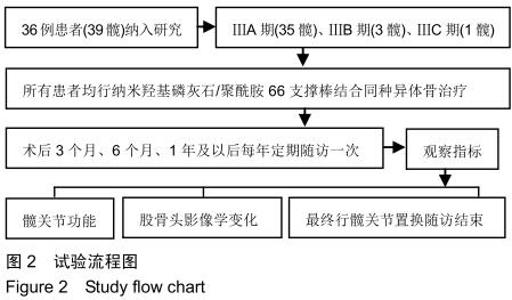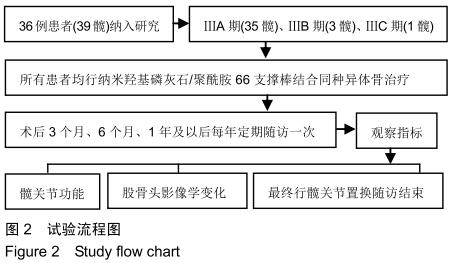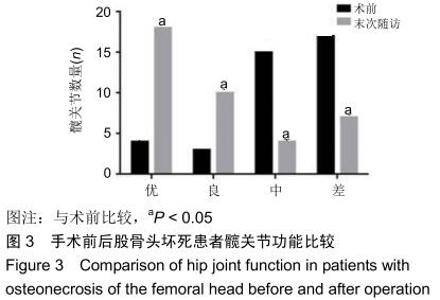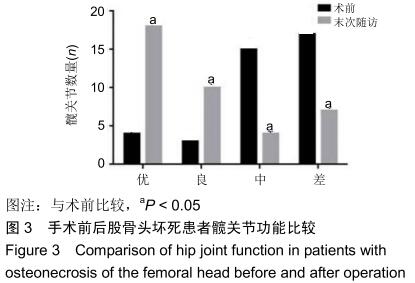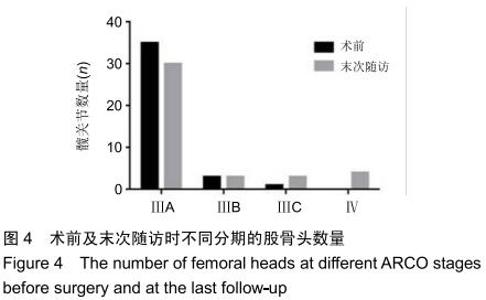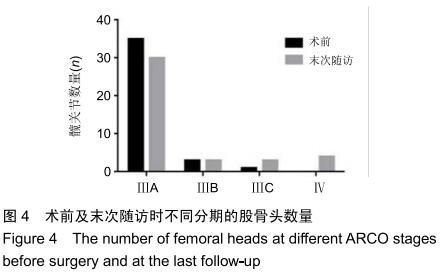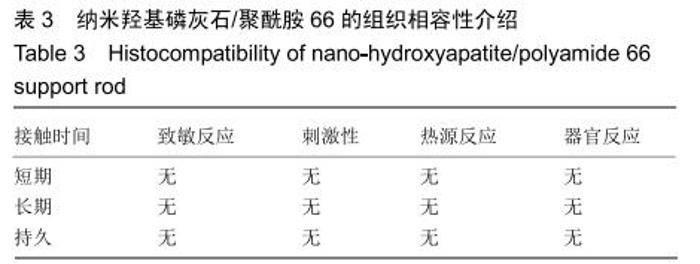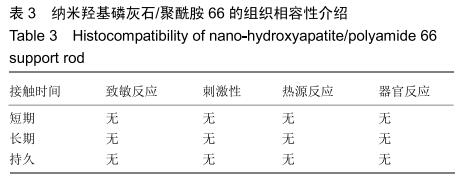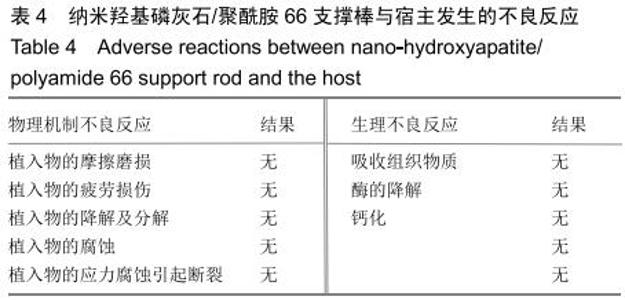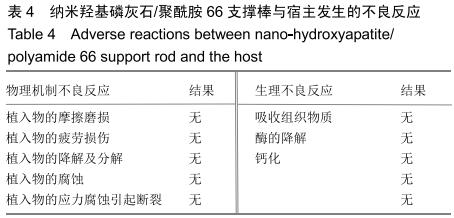Chinese Journal of Tissue Engineering Research ›› 2020, Vol. 24 ›› Issue (28): 4485-4491.doi: 10.3969/j.issn.2095-4344.2320
Previous Articles Next Articles
Nano-hydroxyapatite/polyamide 66 support rod combined with bone allograft for the treatment of ARCO stage III osteonecrosis of the femoral head
Yue Ju’an1, Guo Xiaozhong1,2, Wang Randong1, Li Bing1, Sun Qiang1, Zhang Qidong3, Liu Wangyan1, Chen Jiao1, Li Yingnan1
1Department of Joint Surgery, Aviation General Hospital, Beijing 100012, China; 2Department of Orthopedics, Beijing Jishuitan Hospital, Beijing 100096, China; 3Department of Joint Surgery, China-Japan Friendship Hospital, Beijing 100029, China
-
Received:2020-01-16Revised:2020-01-19Accepted:2020-02-22Online:2020-10-08Published:2020-08-31 -
Contact:Guo Xiaozhong, Chief physician, Department of Joint Surgery, Aviation General Hospital, Beijing 100012, China; Department of Orthopedics, Beijing Jishuitan Hospital, Beijing 100096, China -
About author:Yue Ju’an, MD, Attending physician, Department of Joint Surgery, Aviation General Hospital, Beijing 100012, China -
Supported by:Aviation General Hospital Doctoral Fund, No. YJ-202018 ; the National Natural Science Foundation of China, No. 81705896 ; the National Key Research and Development Project, No. 2017YFC0108102
CLC Number:
Cite this article
Yue Ju’an, Guo Xiaozhong, Wang Randong, Li Bing, Sun Qiang, Zhang Qidong, Liu Wangyan, Chen Jiao, Li Yingnan. Nano-hydroxyapatite/polyamide 66 support rod combined with bone allograft for the treatment of ARCO stage III osteonecrosis of the femoral head[J]. Chinese Journal of Tissue Engineering Research, 2020, 24(28): 4485-4491.
share this article
|
[1] CHEN X, TAN X, GAO S, et al. Sartorius muscle-pedicle bone graft for osteonecrosis of the femoral head.Int Orthop. 2016;40(7): 1417-1425.
[2] KANG JS, MOON KH, KWON DG, et al. The natural history of asymptomatic osteonecrosis of the femoral head.Int Orthop. 2013;37(3):379-384.
[3] XU JL, LIANG ZR, XIONG BL, et al. Risk factors associated with osteonecrosis of femoral head after internal fixation of femoral neck fracture:a systematic review and meta-analysis.BMC Musculoskelet Disord.2019;20(1):632.
[4] SUN W, LI Z, GAO F, et al. Recombinant human bone morphogenetic protein-2 in debridement and impacted bone graft for the treatment of femoral head osteonecrosis.PLoS One. 2014; 9(6):e100424.
[5] KUBO Y, MOTOMURA G, IKEMURA S, et al. Effect of collapse on the deformity of the femoral head-neck junction in osteonecrosis of the femoral head. Arch Orthop Trauma Surg. 2017;137(7):933-938.
[6] 刘心万.补肾壮骨通络汤治疗早期股骨头坏死临床的效果分析[J].实用中医内科杂志,2019,32(10):58-60.
[7] 魏巍,侯德才.中药治疗早中期股骨头坏死的最新研究进展[J].海南医学院学报,2019,25(23):1837-1840.
[8] 姚金龙,冯海波,孙绍裘.桃红四物汤治疗创伤性股骨头坏死临床疗效的观察[J].中国医药科学,2019(21):9-12,59.
[9] 周世博,郑永智.三胶膏联合体外冲击波治疗股骨头坏死的可行性分析[J].中医研究,2019,32(11):51-54.
[10] 徐永明,张浩冲,梁豪君,等.体外冲击波治疗股骨头坏死的研究进展[J].中国医学前沿杂志(电子版),2019,11(4):11-15.
[11] 冷超,王先维.用体外冲击波疗法配合臭氧疗法治疗股骨头坏死的效果研究[J].当代医药论丛,2019,17(10):61-62.
[12] COHEN-ROSENBLUM A, CUI Q. Osteonecrosis of the Femoral Head.Orthop Clin North Am. 2019;50(2):139-149.
[13] FENG W, YE P, NI S, et al. One-stage simultaneous hip-preserving surgeries for the management of bilateral femoral head osteonecrosis: a mean 7.0-year follow-up.J Orthop Surg Res. 2019;14(1):455.
[14] MOON JK, YOON JY, KIM CH, et al. Multiple drilling and multiple matchstick-like bone allografts for large osteonecrotic lesions in the femoral head: an average 3-year follow-up study.Arch Orthop Trauma Surg.2020.doi:10.1007/s00402-020-03364-z.[Epub ahead of print]
[15] XIE P, DENG Y, TAN J, et al. The effect of rotational degree and routine activity on the risk of collapse in transtrochanteric rotational osteotomy for osteonecrosis of the femoral head-a finite element analysis.Med Biol Eng Comput.2020.doi: 10.1007/s11517-020-02137-5. [Epub ahead of print]
[16] WU ZY, SUN Q, LIU M, et al. Correlation between the efficacy of stem cell therapy for osteonecrosis of the femoral head and cell viability.BMC Musculoskelet Disord.2020;21(1):55.
[17] KANEKO S, TAKEGAMI Y, SEKI T, et al. Surgery trends for osteonecrosis of the femoral head: a fifteen-year multi-centre study in Japan.Int Orthop.2020.doi: 10.1007/s00264-020-04480-6. [Epub ahead of print]
[18] PHEMISTER DB. Treatment of the necrotic head of the femur in adults.J Bone Joint Surg Am. 1949;31A(1): 55-66.
[19] 郭晓忠,周乙雄.股骨头髓心减压加异体腓骨移植术治疗股骨头坏死[J].中国修复重建外科杂志,2005,19(9):697-699.
[20] 郭晓忠,李兵,岳聚安,等.髓芯减压植骨加异体腓骨支撑治疗早期股骨头缺血性坏死的单中心长期临床疗效研究[J].中华骨与关节外科杂志,2018,11(12):904-909.
[21] 郭晓忠.股骨头缺血坏死早期微创保头手术的疗效观察[J].骨科临床与研究杂志,2019,4(4): 225-231.
[22] 李子荣.股骨头坏死临床诊疗规范[J].中华骨与关节外科杂志, 2015, 8(1):1-6.
[23] SULTAN AA, KHLOPAS A, SURACE P, et al. The use of non-vascularized bone grafts to treat osteonecrosis of the femoral head: indications, techniques, and outcomes.Int Orthop.2019; 43(6):1315-1320.
[24] 马金辉,孙伟,郭万首,等.股骨头坏死钽棒植入后中期随访失败原因分析[J].中华关节外科杂志(电子版),2017,11(4):331-337.
[25] MA J, SUN W, GAO F, et al. Porous Tantalum Implant in Treating Osteonecrosis of the Femoral Head: Still a Viable Option?Sci Rep. 2016;6:28227.
[26] HU B, YANG X, HU Y, et al. The n-HA/PA66 Cage Versus the PEEK Cage in Anterior Cervical Fusion with Single-Level Discectomy During 7 Years of Follow-Up.World Neurosurg. 2019; 123:e678-678e684.
[27] HUANG J, XIA X, ZOU Q, et al. The long-term behaviors and differences in bone reconstruction of three polymer-based scaffolds with different degradability.J Mater Chem B. 2019;7(48): 7690-7703.
[28] 毛文文,茹江英.羟基磷灰石类陶瓷在骨组织工程中的研究与更广泛应用[J].中国组织工程研究,2018,20(30):4855-4863.
[29] HU J, OU Y, ZHU Y, et al. Effectiveness of nano-hydroxyapatite/ polyamide-66 Cage in interbody fusion for degenerative lumbar scoliosis].Zhongguo Xiu Fu Chong Jian Wai Ke Za Zhi.2019; 33(3): 287-295.
[30] CHEN G, YIN M, LIU W, et al. A Novel Height-Adjustable Nano-Hydroxyapatite/Polyamide-66 Vertebral Body for Reconstruction of Thoracolumbar Structural Stability After Spinal Tumor Resection.World Neurosurg.2019;122:e206-e214.
[31] HU B, WANG L, SONG Y, et al. A comparison of long-term outcomes of nanohydroxyapatite/polyamide-66 cage and titanium mesh cage in anterior cervical corpectomy and fusion: A clinical follow-up study of least 8 years.Clin Neurol Neurosurg. 2019;176: 25-29.
[32] ZHONG W, LIANG X, TANG K, et al. Nanohydroxyapatite/polyamide 66 strut subsidence after one-level corpectomy: underlying mechanism and effect on cervical neurological function.Sci Rep. 2018;8(1):12098.
[33] 王荣民,孙康祺,王建凤,等.天然高分子复合羟基磷灰石材料的制备与应用[J].化学进展,2016,28(6):885-895.
[34] 温从游,孟纯阳,蒋电明.纳米羟基磷灰石/聚酰胺66复合材料的研究及应用[J].中国组织工程研究,2014,18(3):464-469.
[35] ZHAO Z, GUO L, ZHU Y, et al. Clinical Use of a New Nano-Hydroxyapatite/Polyamide66 Composite Artificial Lamina in Spinal Decompression Surgery: More Than 4 Years' Follow-Up. Med Sci Monit. 2018;24:5573-5579.
[36] XIONG Y, REN C, ZHANG B, et al. Analyzing the behavior of a porous nano-hydroxyapatite/polyamide 66 (n-HA/PA66) composite for healing of bone defects.Int J Nanomedicine. 2014;9: 485-494.
[37] 臧晓龙,孙健,李亚莉,等.3D生物打印构建聚乳酸羟基乙酸/纳米羟基磷灰石支架骨形态发生蛋白2缓释复合体的实验研究[J].中国组织工程研究,2016,20(16):2405-2411.
[38] DENG QX, OU YS, ZHU Y, et al. Clinical outcomes of two types of cages used in transforaminal lumbar interbody fusion for the treatment of degenerative lumbar diseases: n-HA/PA66 cages versus PEEK cages.J Mater Sci Mater Med.2016;27(6):102.
[39] SHUAI C, GAO C, FENG P, et al. Grain growth associates mechanical properties in nano-hydroxyapatite bone scaffolds.J Nanosci Nanotechnol.2013;13(8):5340-5345.
[40] YANG P, BIAN C, HUANG X, et al. Core decompression in combination with nano-hydroxyapatite/polyamide 66 rod for the treatment of osteonecrosis of the femoral head. Arch Orthop Trauma Surg.2014;134(1):103-112.
[41] STEVENSON S. Enhancement of fracture healing with autogenous and allogeneic bone grafts. Clin Orthop Relat Res. 1998;(355 Suppl):S239-246.
[42] CAPLANIS N, LEE MB, ZIMMERMAN GJ, et al. Effect of allogeneic freeze-dried demineralized bone matrix on regeneration of alveolar bone and periodontal attachment in dogs.J Clin Periodontol. 1998;25(10):801-806.
[43] 谭新颖.同种异体骨髓间充质干细胞复合同种异体冻干骨修复比格犬半侧下颌骨缺损的实验研究[D].北京:中国人民解放军医学院, 2014.
[44] 张鸣,李翔.脱钙骨基质的临床应用与研究进展[J].医学综述, 2013, 19(14):2540-2543.
[45] ORYAN A, ALIDADI S, MOSHIRI A. Platelet-rich plasma for bone healing and regeneration.Expert Opin Biol Ther. 2016;16(2): 213-232.
[46] DIMITRIOU R, JONES E, MCGONAGLE D, et al. Bone regeneration: current concepts and future directions.BMC Med. 2011;9:66.
[47] MONT MA, CHERIAN JJ, SIERRA RJ, et al. Nontraumatic Osteonecrosis of the Femoral Head: Where Do We Stand Today? A Ten-Year Update.J Bone Joint Surg Am. 2015;97(19): 1604-1627. |
| [1] | Huang Dengcheng, Wang Zhike, Cao Xuewei. Comparison of the short-term efficacy of extracorporeal shock wave therapy for middle-aged and elderly knee osteoarthritis: a meta-analysis [J]. Chinese Journal of Tissue Engineering Research, 2021, 25(9): 1471-1476. |
| [2] | Lu Dezhi, Mei Zhao, Li Xianglei, Wang Caiping, Sun Xin, Wang Xiaowen, Wang Jinwu. Digital design and effect evaluation of three-dimensional printing scoliosis orthosis [J]. Chinese Journal of Tissue Engineering Research, 2021, 25(9): 1329-1334. |
| [3] | Peng Zhihao, Feng Zongquan, Zou Yonggen, Niu Guoqing, Wu Feng. Relationship of lower limb force line and the progression of lateral compartment arthritis after unicompartmental knee arthroplasty with mobile bearing [J]. Chinese Journal of Tissue Engineering Research, 2021, 25(9): 1368-1374. |
| [4] | Wang Yongsheng, Wu Yang, Li Yanchun. Effect of acute high-intensity exercise on appetite hormones in adults: a meta-analysis [J]. Chinese Journal of Tissue Engineering Research, 2021, 25(8): 1305-1312. |
| [5] | Liu Xiangxiang, Huang Yunmei, Chen Wenlie, Lin Ruhui, Lu Xiaodong, Li Zuanfang, Xu Yaye, Huang Meiya, Li Xihai. Ultrastructural changes of the white zone cells of the meniscus in a rat model of early osteoarthritis [J]. Chinese Journal of Tissue Engineering Research, 2021, 25(8): 1237-1242. |
| [6] | Zhao Zhongyi, Li Yongzhen, Chen Feng, Ji Aiyu. Comparison of total knee arthroplasty and unicompartmental knee arthroplasty in treatment of traumatic osteoarthritis [J]. Chinese Journal of Tissue Engineering Research, 2021, 25(6): 854-859. |
| [7] | Liu Lihua, Sun Wei, Wang Yunting, Gao Fuqiang, Cheng Liming, Li Zirong, Wang Jiangning. Type L1 steroid-induced osteonecrosis of the femoral head through femoral head and neck junction decompression by fenestration: a single-center prospective clinical study [J]. Chinese Journal of Tissue Engineering Research, 2021, 25(6): 906-911. |
| [8] | Liu Zhao, Xu Xilin, Shen Yiwei, Zhang Xiaofeng, Lü Hang, Zhao Jun, Wang Zhengchun, Liu Xuzhuo, Wang Haitao. Guiding role and prospect of staging and classification combined collapse prediction method for osteonecrosis of femoral head [J]. Chinese Journal of Tissue Engineering Research, 2021, 25(6): 929-934. |
| [9] | Cao Xuhan, Bai Zixing, Sun Chengyi, Yang Yanjun, Sun Weidong. Mechanism of “Ruxiang-Moyao” herbal pair in the treatment of knee osteoarthritis based on network pharmacology [J]. Chinese Journal of Tissue Engineering Research, 2021, 25(5): 746-753. |
| [10] | Li Yonghua, Feng Qiang, Tan Renting, Huang Shifu, Qiu Jinlong, Yin Heng. Molecular mechanism of Eucommia ulmoides active ingredients treating synovitis of knee osteoarthritis: an analysis based on network pharmacology [J]. Chinese Journal of Tissue Engineering Research, 2021, 25(5): 765-771. |
| [11] | Song Shan, Hu Fangyuan, Qiao Jun, Wang Jia, Zhang Shengxiao, Li Xiaofeng. An insight into biomarkers of osteoarthritis synovium based on bioinformatics [J]. Chinese Journal of Tissue Engineering Research, 2021, 25(5): 785-790. |
| [12] | Deng Zhenhan, Huang Yong, Xiao Lulu, Chen Yulin, Zhu Weimin, Lu Wei, Wang Daping. Role and application of bone morphogenetic proteins in articular cartilage regeneration [J]. Chinese Journal of Tissue Engineering Research, 2021, 25(5): 798-806. |
| [13] | Zheng Xiaolong, He Xiaoming, Gong Shuidi, Pang Fengxiang, Yang Fan, He Wei, Liu Shaojun, Wei Qiushi. Bone turnover characteristics in patients with alcohol-induced osteonecrosis of the femoral head [J]. Chinese Journal of Tissue Engineering Research, 2021, 25(5): 657-661. |
| [14] | Liu Xin, Yan Feihua, Hong Kunhao. Delaying cartilage degeneration by regulating the expression of aquaporins in rats with knee osteoarthritis [J]. Chinese Journal of Tissue Engineering Research, 2021, 25(5): 668-673. |
| [15] | Ma Zetao, Zeng Hui, Wang Deli, Weng Jian, Feng Song. MicroRNA-138-5p regulates chondrocyte proliferation and autophagy [J]. Chinese Journal of Tissue Engineering Research, 2021, 25(5): 674-678. |
| Viewed | ||||||
|
Full text |
|
|||||
|
Abstract |
|
|||||
